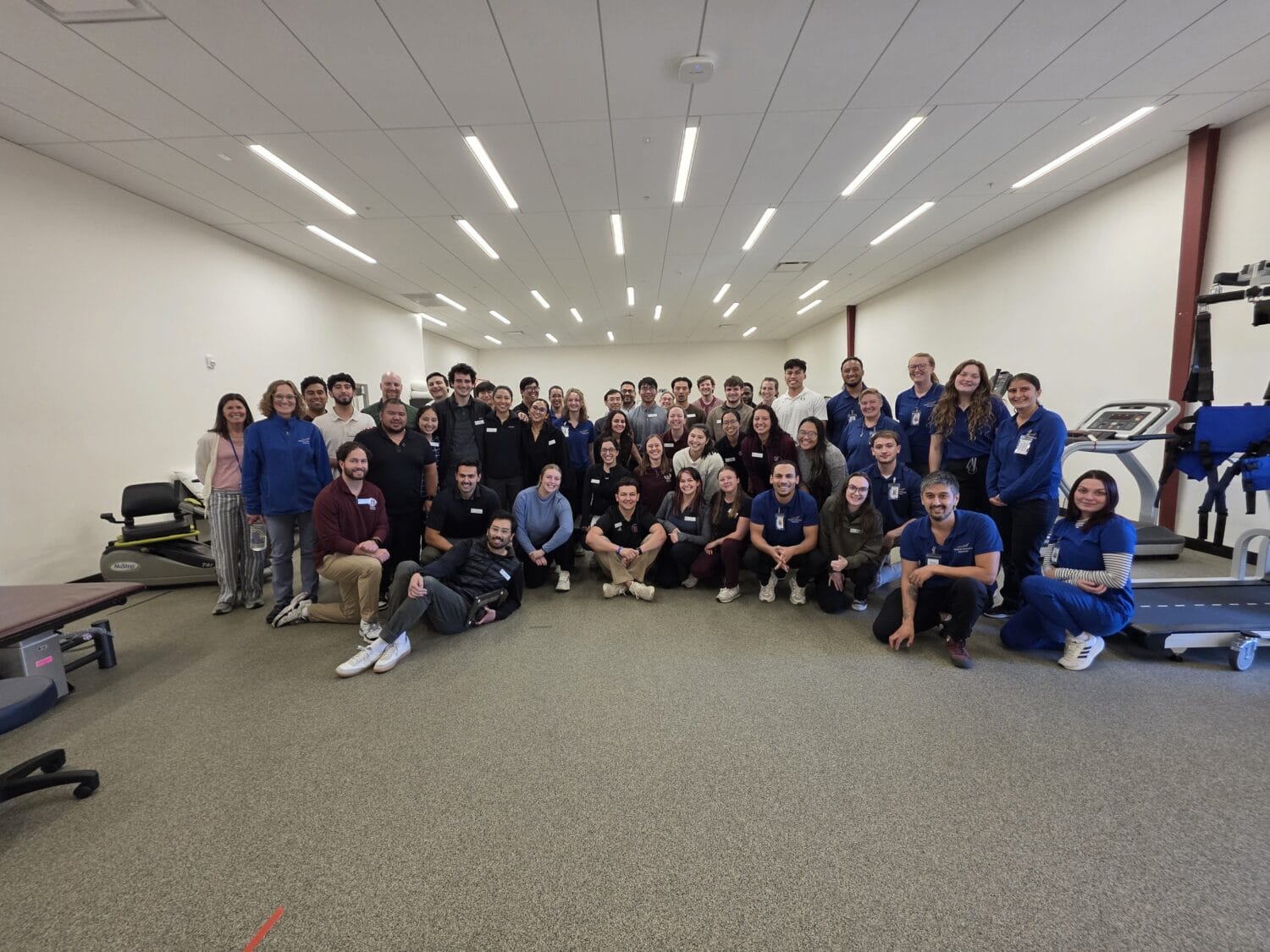WesternU’s Austin Lecture provides insight into gender-affirming care

Amy K. Weimer, MD, FACP, FAAP, Associate Professor of the David Geffen School of Medicine at UCLA and Co-Founder and Medical Director of the UCLA Gender Health Program, presented “Gen Z and Gender X: Gender-Affirming Care for Today’s Youth” at Western University of Health Sciences’ Austin Lecture May 1, 2024.
Weimer opened her talk by defining the terms she would use throughout her presentation.
“When we talk about a person’s gender or their gender identity, we’re talking about their internal sense of self as being male or female or both or neither or another gender altogether,” Weimer said. “A person’s gender expression is their outward display of gender, so that might be their style of dress and hair, it might be the pronouns they use, it might be mannerisms. Those are all parts of gender expression. When we use the term sex, particularly in the medical realms, we’re talking about the sex that was assigned at birth, and that’s generally based on genital anatomy and on chromosomes.”
Cisgender is a term that we use when a person’s gender identity or sense of self aligns with the sex they were assigned at birth. And the term transgender describes a person whose gender identity is different from the sex they were assigned at birth, Weimer said.
“Not all people who we think of as transgender identify with that word. So it’s really important to understand the terms that a person uses to describe their own experience and not assume that’s a term that is comfortable to them,” she said.
Transition generally refers to the process by which a person moves toward congruence with their gender. They’re trying to align their experience more with their gender identity. And affirmation is all the things we can do around a person to really support their authentic gender expression, Weimer said.
There are particular health vulnerabilities we see in trans kids and trans adolescents, including a greater prevalence of substance abuse, risky sexual behaviors, eating disorders and depression.
“One of the things I think is important for people who care for adolescents in any way to recognize is when any of these things are the presenting concern, if somebody’s coming in with substance abuse or depression, we need to think about gender expansiveness as one possible element of what’s driving that behavior so it needs to be part of our history taking and part of our consideration,” Weimer said.
What does it mean to provide affirmative care, to provide care in a way that supports a person in their gender?
“It starts with the family. We know that our patients’ outcomes are better if we support the entire family in supporting that youth,” Weimer said. “There are lots of things I can do to help the person in front of me, but if they’re going home to an environment that is not supportive, their outcomes are going to be much worse.”
A study done at a Toronto youth clinic shows that, regardless of the age at which a child recognizes their gender identity, on average, kids wait 1 ½ to 2 years to disclose that to their family, Weimer said.
“There is this long-internalized phase where they’re recognizing their gender, they’re trying to make sense of it, trying to understand it, before they feel comfortable talking about it with their family,” she said. “What ends up happening is by the time they’re talking about it they have an urgency. There’s a reason they’re talking about it. They may want medical interventions. They want their family to support them often in some action.”
Parents may experience this as very abrupt. They have their own reactions where they’re worried about their children’s long-term safety, and they often feel the best thing for their child may be to actually get them to work on fitting in with their cisgender peers.
“What we found is that parents really have their own journey. They need to absorb the information. They need to educate themselves. They need the space to talk about this and those spaces usually shouldn’t be in front of their children,” Weimer said. “We want families communicating, but we want parents to do all of that questioning and reflecting and self-education in other spaces. The reason I bring that up is we want to be mindful when we’re having discussions with families. Is this something this young person should be hearing? Or should I be talking to these parents in private? So trying to create those spaces for everyone to have their own journey.”
The diagnosis that we are usually working with when we’re providing gender-affirming care is gender dysphoria, Weimer said, which is found in the DSM-5 (Diagnostic and Statistical Manual of Mental Disorders, Fifth Edition), the American Psychiatric Association’s professional reference book on mental health and brain-related conditions.
“It has long been classified as a psychiatric disorder and there has been a movement in the trans community and the community of providers to move this out of mental disorders because the issue is not one of a psychiatric disorder but one of the gender incongruence piece of this,” Weimer said. “We don’t know all of the elements that contribute to somebody experiencing this, but the more recent classification systems have moved it out of psychiatric conditions and into conditions related to sexual health and is now using the term gender incongruence.
“Essentially what we’re looking for diagnostically is that there has been a persistent incongruence, a mismatch, between somebody’s experienced gender and their assigned sex that has lasted over six months,” she added. “That incongruence can manifest in a lot of ways. For some people it’s physical. They don’t like these parts of my body. ‘I don’t like the way my body is developing with secondary sex characteristics.’ It could be social. ‘I don’t want to be seen as a girl. I want to be seen as the boy that I am.’ And it can be emotional. ‘I have the emotions of another gender.’ And that incongruence according to this criteria is causing clinically-significant distress or dysphoria.”
The medical treatments we provide, and even the non-medical treatments we provide, are evidence-based treatments, so it is science-driven medicine, to reduce that gender incongruence, and thus improve not only gender dysphoria but wellness and functioning and overall health, Weimer said. “It’s really by reducing that incongruence that we see people be able to live their best lives,” she said.
What do we know about the outcomes of medical treatment in young people?
“The outcomes data that we have is very consistently and clearly showing that gender-affirming treatment that is specifically provided during adolescence is associated with better outcomes in adults,” Weimer said. “So often we’ll get the question, ‘Why shouldn’t we just wait until they reach adulthood and they can decide then what they want to do?’ But people actually do better if they are provided treatment during the adolescent period, as compared to having them wait until adulthood, when that is appropriate and desired for them. So there is a very compelling reason not to just keep deferring the discussion.”
One question that often comes up is, “What about regret? How do we know people won’t regret this?” Weimer said.
“We don’t know for any individual what their future holds. This is true across all aspects of medicine. We are always making the best decisions we can with the person we have in front of us with the evidence we have available,” she said.
Studies show regret rates for surgeries in the range of 0.3 to 0.6%. Usually people who expressed regret have either poor social support or they had complications or undesired outcomes of their surgeries, Weimer said. And just to give this some context, in a comparison study looking at surgeries in the general population – orthopedics, cancer surgeries, and general surgeries like appendectomies – 14.4% patients reported surgical regret.
“Regretting a medical intervention is not an uncommon thing in patients. The regret rates in this particular area of care, although they get a ton of media attention, are actually very uncommon,” Weimer said. “We always need to be thinking about the risk-reward for any patient and recognizing that not providing treatment is not a benign option, not providing treatment when it is indicated it can be harmful.”
Weimer gave a case example of “Annie,” a 12-year-old girl assigned male at birth with a history since age 4 displaying female gender expression. At age 5 she asserted her female identity verbally and entered into kindergarten as a girl undisclosed to anyone in the community. Is preventing her from receiving treatment a reasonable and an ethical option?
“If this kid goes through a testosterone puberty when she is undisclosed as a trans girl, you can only imagine not only the emotional distress that she would have, but also the safety issues that she would have,” Weimer said. “Not allowing her access to this care is egregiously unethical.”
Weimer provided suggestions to current and future health care professionals on how they can help their patients.
“Whatever space you’re in, you can refer to people the way they want to be referred to. The correct name they provide to you. Respect patients’ confidentiality if they talk to you about their experience don’t talk about it with their family unless you have talked with them about that,” Weimer said. “Model affirmation, so once they have disclosed to you, support them in their identity, and if they want you to do that with their loved ones in the room, that’s a great place to model that. Keep the communication going. Model your patient’s language for their experience and their anatomy.”
Also, see the patient beyond just their gender experience. Try to avoid gendered language.
“If you make a mistake, if you use the wrong name, the wrong pronouns, the wrong language, acknowledge it if you notice it – the patient certainly did – apologize and then move on,” Weimer said. “If we sit in this place, ‘I’m so sorry I said that, I know better,’ and you start spinning on it, it makes the patient feel like they have to take care of you because you’re feeling so anxious. It’s our job to just take ownership of it and apologize and move on.”
The Dr. Robert L. Austin Endowed Lectureship in Pediatric Medicine, Pharmacology and Health Care Policy is made possible by a generous donation from Mrs. Gloria L. Austin of La Mirada, California in memory of her husband, Robert, a pediatrician, College of Osteopathic Medicine of the Pacific (COMP) faculty member, and early supporter of the University. In addition to the lecture, the endowment provides funds for annual scholarships for both an osteopathic medical student and a pharmacy student.
Prior to Weimer’s presentation, WesternU President Robin Farias-Eisner, MD, PhD, MBA, thanked the Austin family members in attendance.
“This is a tradition that we hold dear to us. We’re delighted that you’re here,” Farias-Eisner said. “This is a coveted endowed lectureship. We are very grateful for your continued support of this endeavor.”



